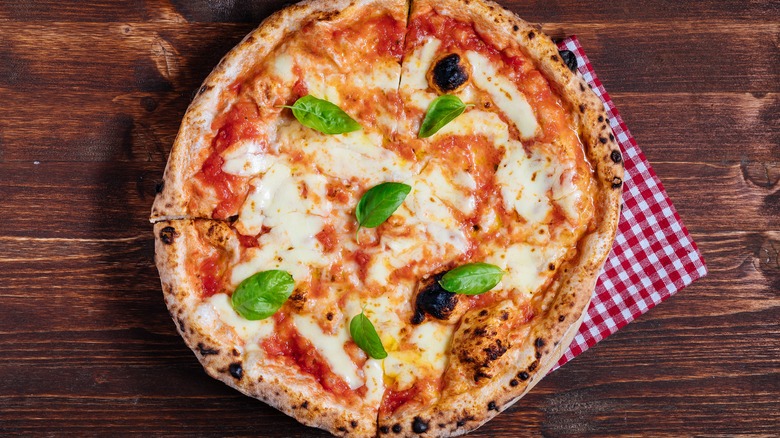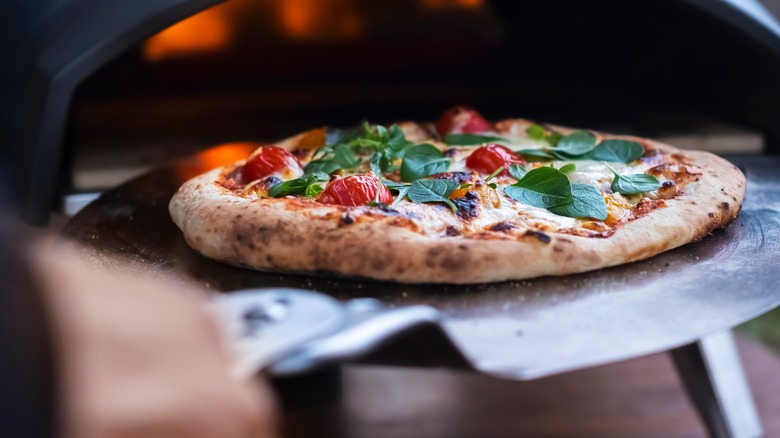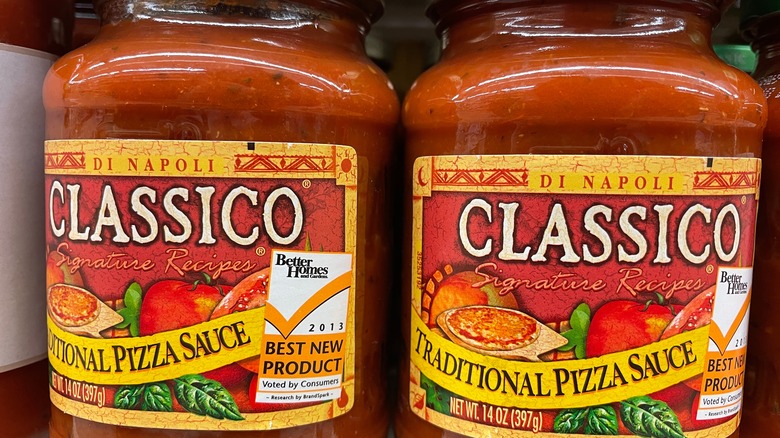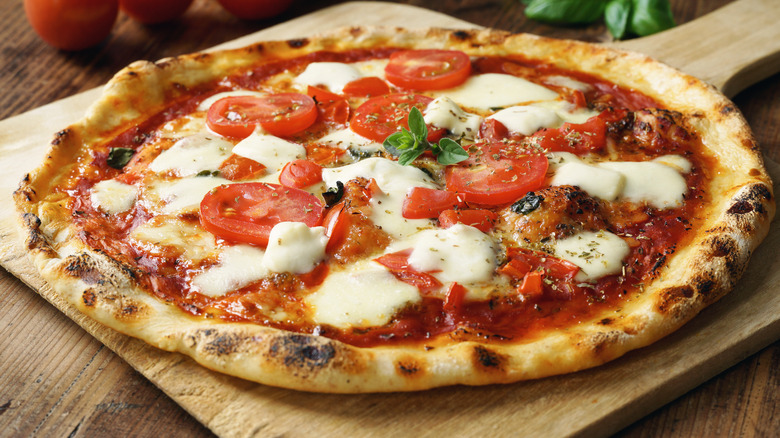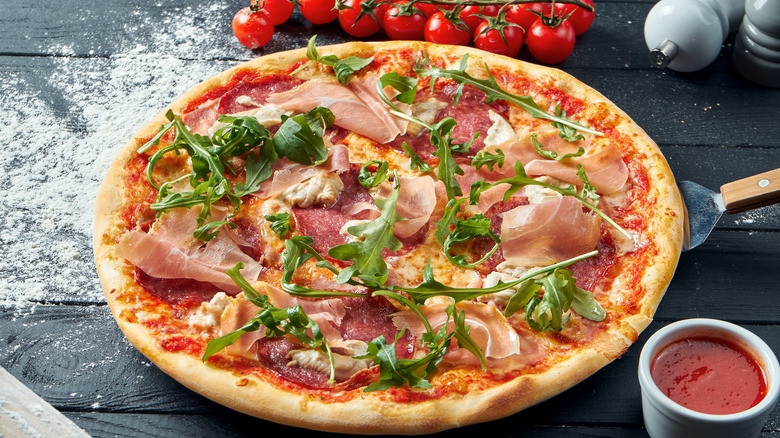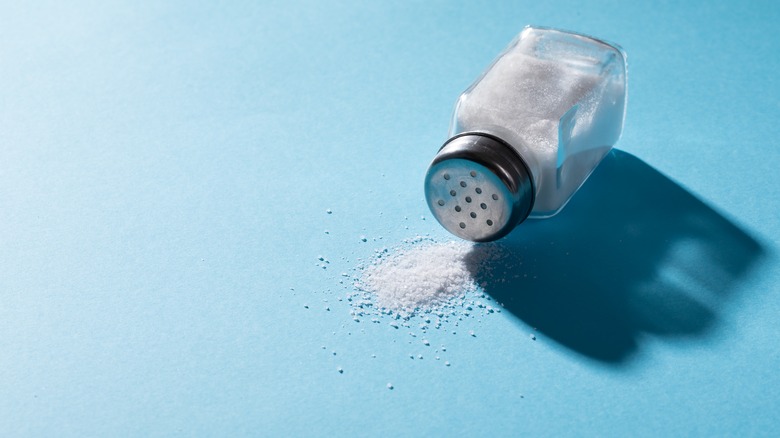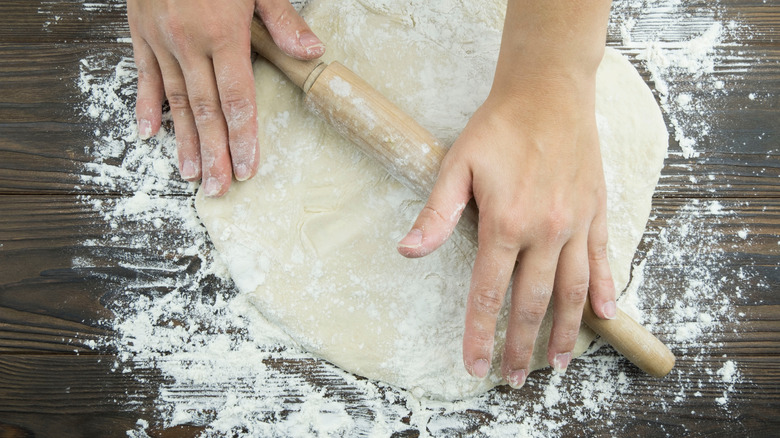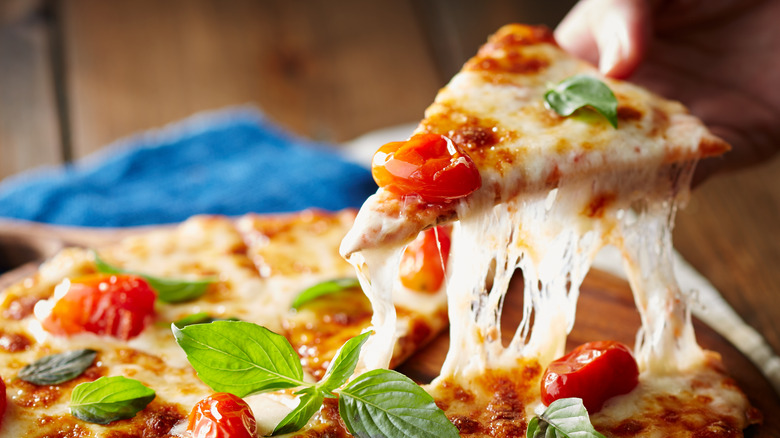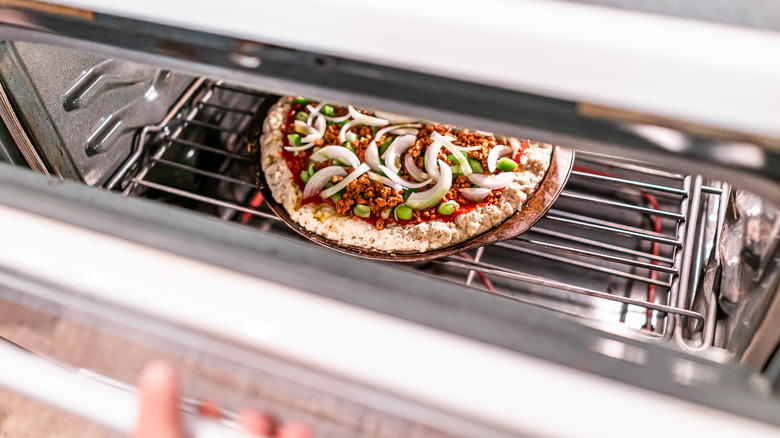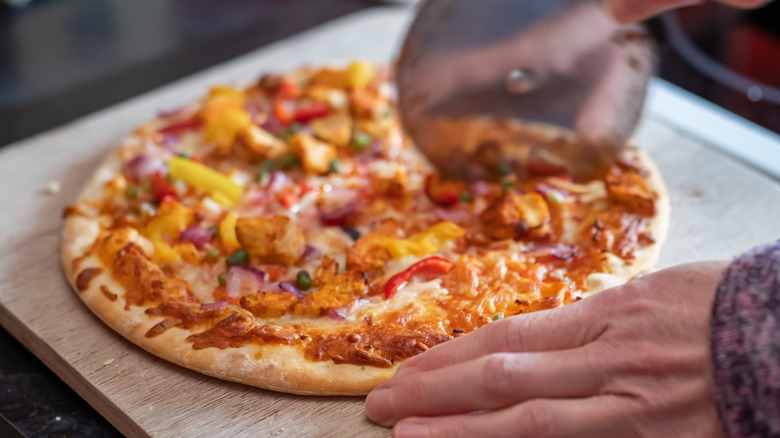Mistakes Everyone Makes With Pizza
Pizza is one of the most popular comfort foods around for a good reason. It's saucy and cheesy, full of carby dough baked to perfection. It's easy to hit up your favorite pizza spot for a slice or have a pie delivered to your home. But nothing is more gratifying than when you create your very own pizza. Homemade pizza can be tailored to your liking, whether you want a Detroit-Style Deep Dish recipe or a veggie NYC-style recipe, and eating it can taste even better because of the work put into it. You may even take your time eating. But probably not.
When making homemade pizza, there are a lot of common mistakes. The type of flour you use is just as important as how you place your toppings on the dough. You want your pizza to come out the absolute best. And we're here to make sure that happens. Here are the top mistakes everyone makes with pizza and how you can avoid making them, too.
Not cooking at the right temperature
Soggy pizza dough is not anything anyone ever wants when trying to master their own pie at home. Pay close attention to how you cook the pizza dough is the key to ensuring this doesn't happen. The temperature at which you cook your pizza is very important and can determine whether or not you're looking at a soggy pie. To get that perfect crust, you'll want to try baking your pie at around 475 F for roughly 10-12 minutes for ultimate perfection that is anything but soggy.
Crust Kingdom says the key is to make sure the bottom of the pizza gets enough heat. Higher temperatures work well in pizza ovens, but you may need to cook for longer at a lower temperature with regular home kitchen ovens. Consider lowering your pizza on the oven rack, so the bottom gets as much heat as the top.
Using pre-made pizza sauce from the store
We know how easy it is to grab that jar of pizza sauce off the shelf and bring it home to slather on your dough. But using a pre-made sauce might not always be the best option when you're looking to create some flavor in your homemade pizza. This step is definitely one of those top mistakes many people make with pizza, but you don't have to be one of those people.
Mediocre Chef says most of those jarred pizza sauces you buy at the store are way too sweet, which can impact how your pizza tastes. Making your own sauce can help add flavor, and it doesn't have to be hard or expensive. Simply stick with a can of tomatoes and the herbs and seasonings of your choice (think oregano), and you'll easily create a delicious sauce that will outshine the ones that come in the jar any day.
Pizza dough didn't have enough time to rest
We know that the pizza dough is a big part of the overall result. We want the middle of the pizza to be warm and never soggy, while the crust should be fluffy, with just the right amount of crunch from those crispy golden edges. While how you make the dough matters, a critical step is how long you let the dough sit. Simply put, this equally important technique is one step that should never be skipped for excellent pizza.
After you add all the ingredients to your dough and complete the kneading, you'll end up with a product that it's nice and smooth. The next step you will need to do is to allow the dough to rest, says Baking Kneads. During this time, while the dough rests, the yeast expands. The reason for this (and why this is so important) is to help make the dough fluffy, ensuring a killer crust after baking.
Toppings are not added in the right order
Some things in life are just a given. The way you add the toppings to a pizza is one of them. You wouldn't add cheese first and then the sauce, right? You could, of course, but you probably wouldn't have a pizza that tasted the way it should. The order of how you place your ingredients on your pizza is significant and shouldn't be played around with.
Crust Kingdom says toppings, such as your meats and veggies, usually need the direct heat, which is why they are added last, as opposed to the cheese and sauce, which require less heat and are added first (sauce first and then the cheese).
Speaking of the correct order, let's not forget one of the last steps to making your pizza. Be sure to baste your crust with olive oil before popping it in the oven. This step will help add flavor so your homemade pizza will taste just like delivery, but even better.
Not using the right flour for your dough
When you think about making your pizza dough, you might not necessarily consider which type of flour to use. Instead, you may just reach into your cabinet and pull out any ol' flour you have stowed away. But when it comes to making quality pizza dough, the flour counts, and you shouldn't use just anything.
The Pizza Heaven says flour is essential when making pizza dough because it helps flavor and consistency. Flour containing too much gluten, such as flour used for bread, will make dough tough and not a great choice when looking for a fluffy pizza. Flour that has neither too much gluten nor too little is more desirable when making pizza, such as an Italian Tipo 00 flour, which has the right amount of gluten and absorbs water quickly to achieve a soft dough rather than a tough one.
Not adding the right amount of salt
Salt can really make or break a dish. Adding too much can utterly overpower and destroy flavors, but not adding enough can keep the overall taste rather bland. You have to create a happy balance when using salt on anything from sauce to the dough for your homemade pizza. If you don't use the right amount of salt for your dough, you'll fall into one of the top mistakes everyone makes with pizza.
To ensure that doesn't happen, use salt wisely when making pizza dough. Homemade Pizza Pro says to consider the toppings, especially cured meats like pepperoni or salami, when adding salt to pizza dough. Salt helps add flavor, but too much isn't a good thing, and the last thing you want is an overseasoned pie. The salt you add to the dough also helps with the gluten formation, slowing down the fermentation and giving the dough more elasticity.
Not rolling or stretching the dough properly
Once you make your dough, you'll have to knead it and roll it out to make it the right canvas for your toppings. But knowing how to roll (or stretch) the dough is key. According to Kitchen Seer, you can roll or stretch your dough, depending on the type of crust you want. For example, rolling your dough will provide a thinner crust, while stretching the dough will make it fluffier. It all depends on how you want your crust to come out once you take it out of the oven.
However, beware of overworking your dough by rolling or stretching too much, which can cause it to turn out a lot tougher than anyone wants. For example, when using a rolling pin, be careful not to overdo it. You never want to remove all the air bubbles in the dough because it will turn out too dense and tough. Keep the rolling at a minimum, so some air bubbles stay intact, and your dough comes out to fluffy perfection.
Adding too much cheese
Who doesn't enjoy pulling a slice from a pizza pie and watching the cheese stretch? Maybe it even catches the light just right as its aroma wafts through the air. But sometimes, being too cheesy isn't always a good thing. When you add too much cheese to your pizza, the crust can get soggy, says My House of Pizza. And, of course, no one wants a soggy pizza.
But besides making a pizza soggy, adding too much cheese can also weigh down the crust and make it lose the crisp crunch many of us love. Biting down on a soggy crust is not what we had in mind when making homemade pizza, and we're sure you didn't either. Keep your pizza (and the crust) well-balanced by adding just the right amount of cheese that will make you swoon but won't kill your crust in the process.
You aren't using your broiler
When making a pizza at home, we want a crust that is not only on the crispy side but also has the right amount of golden color. No one wants to take a pizza out of the oven and have it look and taste undercooked. But achieving a perfectly baked crust can sometimes be a challenge. However, it doesn't have to be.
According to Baking Steel, the secret is cooking your pizza with both a convection oven and a broiler. The broiler can help achieve the right color and crispiness to your crust in only a few minutes at a high temperature. And it doesn't matter whether you have a gas or electric oven, as broiling can be done in both. A helpful tip to remember is that gas and electric ovens heat differently; therefore, timing can vary depending on your choice of tool.
You haven't invested in a pizza cutter
Once you have made your pizza and it's baked to perfection in the oven, it is time to dig in. While you might think just any knife will do the trick when cutting through your homemade crust, you may want to think again. This move is definitely one of the biggest mistakes many people make with pizza. We say, move over kitchen knife; this is a job for a pizza cutter. There are a lot of uses for pizza cutters, but the ultimate is slicing through homemade pizza.
Dalstrong says a regular kitchen knife can break the ingredients apart when trying to cut through the pizza. However, a pizza cutter can slice through with ease without ruining anything in its way. Pizza cutters are designed to cut pizza, so it's easy to control when making your way through the dough and ingredients. A quality, sharp pizza cutter will usually only require one slice through rather than a constant back and forth movement, which can cause tearing.
